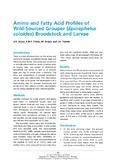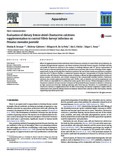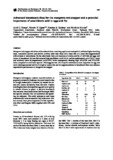| dc.contributor.author | Alava, Veronica R. | |
| dc.contributor.author | Priolo, Flora Mae P. | |
| dc.contributor.author | Toledo, Joebert D. | |
| dc.contributor.author | Rodriguez Jr., Jesus C. | |
| dc.contributor.author | Quinitio, Gerald F. | |
| dc.contributor.author | Sa-an, Analyn C. | |
| dc.contributor.author | de la Peña, Milagros R. | |
| dc.contributor.author | Caturao, Romeo D. | |
| dc.contributor.editor | Rimmer, Michael A. | |
| dc.contributor.editor | McBride, Shannon | |
| dc.contributor.editor | Williams, Kevin C. | |
| dc.date.accessioned | 2015-10-13T07:16:39Z | |
| dc.date.available | 2015-10-13T07:16:39Z | |
| dc.date.issued | 2004 | |
| dc.identifier.citation | Alava, V. R., Priolo, F. M. P., Toledo, J. D., Rodriguez Jr., J. C., Quinitio, G. F., Sa-an, A. C., … Caturao, R. D. (2004). Lipid nutrition studies on grouper (Epinephelus coioides) larvae. In M. A. Rimmer, S. McBride, & K. C. Williams (Eds.), Advances in grouper aquaculture (pp. 47–52). Canberra: Australian Centre for International Agricultural Research. | en |
| dc.identifier.isbn | 9781863204385 | |
| dc.identifier.uri | http://hdl.handle.net/10862/2410 | |
| dc.description.abstract | The main objectives of this project were to study the lipid chain transfer from the egg stage through hatching and the patterns of lipid conservation or loss during starvation and feeding of larvae in order to elucidate the lipid metabolism of grouper (Phase 1); to determine the fatty acid composition of highly unsaturated fatty acid (HUFA) boosters and enriched live food organisms to enable the possibility of choosing food organisms that provide various dietary levels and ratios of docosahexaenoic acid (DHA), eicosapentaenoic acid (EPA) and arachidonic acid (ARA, Phase 2); and to determine the effect of Brachionus and Artemia, containing different levels and ratios of DHA:EPA:ARA, on the growth and survival of grouper larvae (Phase 3). Total lipids (TL) of samples were extracted and separated into neutral (NL) and polar lipids (PL). The samples collected in Phase 1 were floating neurula eggs, newly hatched (NHL) and unfed 4-day larvae; larvae fed with live food organisms for 25 and 35 days or starved for 3 days; and wild-sourced larvae starved for a week. In Phase 2, the samples collected were phytoplanktons, Brachionus cultured in phytoplankton for 4 days, Diaphanosoma celebensis and Pseudodiaptomus annandalei. In phase 3, larvae were fed Brachionus until day 14 and at day 25 with Artemia. E. coioides eggs contained high DHA, EPA and ARA, demonstrating their importance in larval development. Larvae primarily spent NL as energy, whereas PL was generally conserved. Wild grouper larvae had higher levels of PL than NL, whereas hatchery-sourced eggs and larvae contained higher levels of NL than PL. Based on the lipid content of wild larvae, high phospholipid diets were essential for larvae survival and normal development. A variety of products were effective in enriching the HUFA content (particularly ratios of DHA, EPA and ARA) of live food organisms. HUFA-enriched live food organisms enhanced the growth, survival and pigmentation in grouper larvae. | en |
| dc.language.iso | en | en |
| dc.publisher | Australian Centre for International Agricultural Research | en |
| dc.relation.ispartofseries | ACIAR Monograph 110 | en |
| dc.subject | Epinephelus coioides | |
| dc.subject | Groupers | en |
| dc.subject | Docosahexaenoic acid | en |
| dc.subject | Eicosapentaenoic acid | en |
| dc.title | Lipid nutrition studies on grouper (Epinephelus coioides) larvae | en |
| dc.type | Book chapter | en |
| dc.citation.spage | 47 | |
| dc.citation.epage | 52 | |
| dc.subject.asfa | lipids | en |
| dc.subject.asfa | fatty acids | en |
| dc.subject.asfa | arachidonic acid | en |
| dc.subject.asfa | starvation | en |
| dc.subject.asfa | survival | en |
| dc.subject.asfa | fish larvae | en |
| dc.citation.bookTitle | Advances in grouper aquaculture | en |



